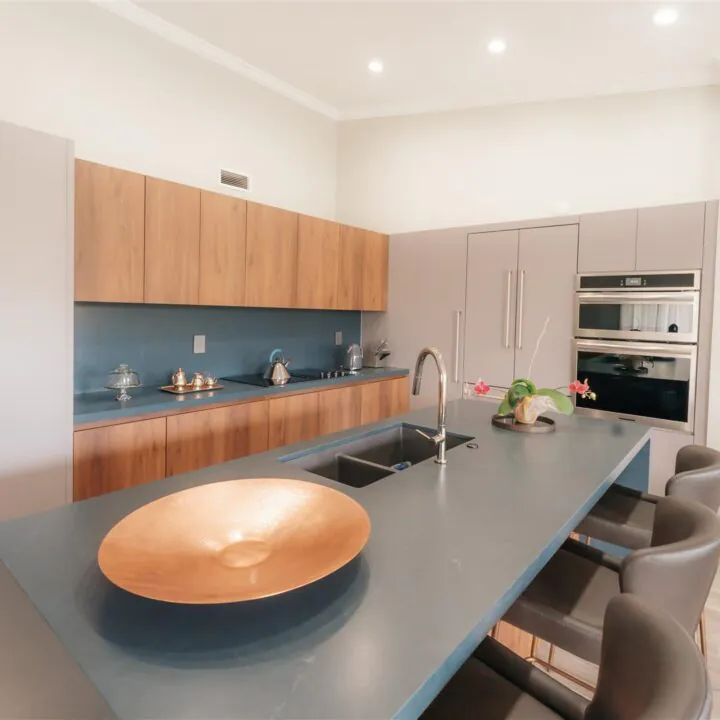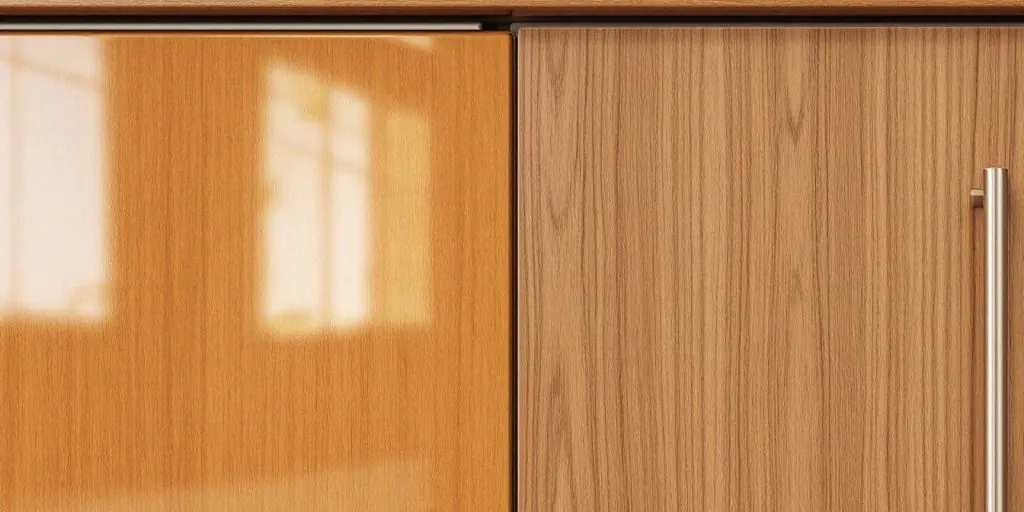When it comes to finishing your kitchen cabinets, choosing between lacquer and veneer can be tricky. Both options have their unique benefits and styles, making it essential to understand what each finish offers. This article will guide you through the differences, advantages, and maintenance tips for lacquer and veneer finishes, helping you make the best decision for your kitchen.
Key Takeaways
- Lacquer finishes are durable and customizable, ideal for busy kitchens.
- Veneer finishes provide a natural wood look while being heat and moisture resistant.
- Lacquer requires regular maintenance to keep its shine, while veneer is easier to repair.
- Cost can vary, with lacquer often being pricier but offering long-term value.
- Understanding your kitchen’s needs is crucial in choosing the right finish.
Understanding Lacquer and Veneer Finishes

What is Lacquer Finish?
Lacquer is a fast-drying finish that creates a hard protective layer on wood surfaces. It is known for its smooth and glossy appearance, making it a popular choice for kitchen cabinets. Here are some key points about lacquer:
- Quick drying: Reduces waiting time between coats.
- Durable: Offers strong protection against scratches and moisture.
- Variety of finishes: Available in matte, satin, and glossy options.
What is Veneer Finish?
Veneer finish involves applying a thin layer of wood over a core material. This finish enhances the natural beauty of the wood while providing some protection. Key aspects include:
- Natural look: Preserves the wood grain and texture.
- Eco-friendly: Uses less wood than solid wood finishes.
- Versatile: Can be stained or painted to match your decor.
Key Differences Between Lacquer and Veneer
| Feature | Lacquer | Veneer |
|---|---|---|
| Application | Sprayed or brushed on | Thin layer glued on |
| Durability | Highly durable | Less durable than lacquer |
| Finish | Glossy, smooth | Natural wood appearance |
| Maintenance | Easy to clean | Requires careful handling |
Lacquer provides a hard-wearing finish, while veneer offers a more natural aesthetic. Choosing the right finish depends on your kitchen’s needs and style preferences.
Benefits of Lacquer Finish for Kitchen Cabinets
Durability and Protection
Lacquer finishes are known for their strong protective layer. This makes them perfect for kitchens that see a lot of action, especially in homes with kids or pets. Here are some key points:
- Resistant to scratches: Lacquer can withstand daily wear and tear.
- Water-resistant: It protects against spills and moisture.
- Long-lasting: With proper care, lacquer can maintain its beauty for years.
Customization Options
One of the best things about lacquer is how you can customize it. You can:
- Mix different colors to create a unique look.
- Add layers for effects like antiquing.
- Choose from various finishes, including high gloss, which offers a smooth, consistent look that absorbs light, minimizing the appearance of fingerprints and smudges.
Maintenance and Care
While lacquer is durable, it does need some maintenance to keep it looking great:
- Regular cleaning: Wipe down surfaces to remove dirt and grime.
- Occasional polishing: This helps maintain the shine.
- Avoid harsh chemicals: Use gentle cleaners to prevent damage.
Lacquer finishes not only enhance the beauty of your kitchen but also provide excellent protection against everyday challenges. They are a smart choice for any busy kitchen!
Advantages of Veneer Finish for Kitchen Cabinets
Aesthetic Appeal
Veneer finishes provide a beautiful look that showcases the natural wood underneath. This allows you to enjoy the elegance of wood grain while adding a touch of sophistication to your kitchen.
Heat and Moisture Resistance
Veneer is known for its ability to resist heat and moisture, making it a great choice for kitchens. This durability helps prevent damage from spills and high temperatures, ensuring your cabinets last longer.
Ease of Repair
One of the best things about veneer is that it’s easy to repair. If you get a scratch or dent, you can often fix it without needing to replace the entire panel. This saves time and money in the long run.
Veneer finishes are a smart choice for anyone looking to balance beauty and practicality in their kitchen design.
Key Benefits of Veneer Finishes:
- Cost-effective: Compared to solid wood, veneer cabinets offer cost savings without compromising aesthetics.
- Versatile: Available in various colors and stains, allowing for customization.
- Durable: Resistant to everyday wear and tear, making them suitable for busy kitchens.
Comparing Costs: Lacquer vs. Veneer
Initial Costs
When considering finishes for your kitchen cabinets, the initial costs can vary significantly between lacquer and veneer. Here’s a quick breakdown:
| Finish Type | Average Cost per Square Foot |
|---|---|
| Lacquer | $3 – $5 |
| Veneer | $2 – $4 |
Long-term Value
While lacquer may have a higher upfront cost, it often provides better long-term value due to its durability. Here are some points to consider:
- Lacquer is resistant to scratches and moisture, making it last longer.
- Veneer can be more susceptible to damage, which may lead to additional repair costs over time.
- Both finishes can enhance the overall value of your kitchen, but lacquer may offer a better return on investment.
Cost-effective Alternatives
If you’re on a budget, consider these alternatives:
- Laminate: A more affordable option that mimics the look of wood.
- Painted Finishes: Can be cheaper than both lacquer and veneer.
- DIY Options: Applying a finish yourself can save on labor costs.
In summary, while lacquer may cost more initially, its durability and maintenance benefits can make it a wise investment for your kitchen cabinets. Choosing the right finish depends on your budget and long-term plans for your kitchen.
Choosing the Right Finish for Your Kitchen
When it comes to selecting the perfect finish for your kitchen, there are several factors to consider. Your choice can greatly impact both the look and functionality of your space. Here are some key points to help guide your decision:
Assessing Your Kitchen Needs
- Durability: Consider how much wear and tear your cabinets will face. If you have kids or pets, a more durable finish like lacquer might be ideal.
- Aesthetic: Think about the style you want to achieve. Do you prefer a modern look or something more traditional? This will influence your finish choice.
- Maintenance: Some finishes require more upkeep than others. If you want something low-maintenance, look into options like melamine or laminate.
Consulting with Experts
- Get Professional Advice: Speak with kitchen design experts to understand the pros and cons of each finish.
- Sample Testing: Request samples to see how different finishes look in your kitchen’s lighting.
- Budget Considerations: Discuss your budget with professionals to find a finish that meets your needs without breaking the bank.
Making the Final Decision
- Weigh Your Options: List the finishes you’re considering and their benefits.
- Visualize the Outcome: Use design software or mood boards to visualize how each finish will look in your kitchen.
- Trust Your Instincts: Ultimately, choose a finish that resonates with your personal style and meets your practical needs.
Choosing the right finish is not just about aesthetics; it’s about creating a space that works for you and your family.
By carefully considering your kitchen needs, consulting with experts, and making an informed decision, you can find the perfect finish that enhances both the beauty and functionality of your kitchen. Remember, the right choice can elevate your kitchen’s overall appeal, making it a welcoming space for family and friends.
Maintenance Tips for Lacquer and Veneer Finishes

Regular Cleaning
To keep your lacquer and veneer finishes looking great, regular cleaning is essential. Here are some tips:
- Use a soft, damp cloth to wipe surfaces.
- Avoid harsh chemicals that can damage the finish.
- Clean spills immediately to prevent stains.
Handling Repairs
If your lacquer or veneer gets damaged, here’s how to handle repairs:
- For minor scratches, use a matching touch-up pen.
- For deeper scratches, sand lightly and reapply the finish.
- If the damage is extensive, consider professional help.
Preventive Measures
Taking preventive measures can extend the life of your finishes. Here are some strategies:
- Use coasters and placemats to protect surfaces from heat and moisture.
- Avoid placing heavy items on veneer surfaces to prevent warping.
- Keep your kitchen well-ventilated to reduce humidity.
Remember, regular maintenance not only keeps your kitchen looking beautiful but also helps in preserving the quality of your cabinets for years to come!
Popular Trends in Kitchen Cabinet Finishes
Modern Lacquer Finishes
Lacquer finishes are becoming increasingly popular in modern kitchens. They provide a sleek and shiny look that can brighten up any space. Homeowners love the variety of colors available, allowing for personalized designs that match their style.
Classic Veneer Styles
Veneer finishes are also making a comeback. They offer a natural wood look that adds warmth to kitchens. The thin layers of wood allow for a range of colors and stains, making it easy to customize. Many people appreciate the superior heat resistance of veneer, especially in warmer climates.
Combining Finishes for a Unique Look
A growing trend is the combination of different finishes. Mixing lacquer and veneer can create a unique aesthetic that stands out. For example, using lacquer for cabinet doors and veneer for the sides can add depth and interest to your kitchen design.
Here’s a quick comparison of these trends:
| Finish Type | Aesthetic Appeal | Durability | Customization Options |
|---|---|---|---|
| Lacquer | High | Moderate | Wide |
| Veneer | Natural | High | Moderate |
In summary, the choice of finish can significantly impact your kitchen’s overall look and feel.
Choosing the right finish is essential for both aesthetics and functionality. It’s worth considering your kitchen’s style and your personal preferences when making this decision.
Conclusion
Choosing between lacquer and veneer for your kitchen cabinets can be a tough decision. Lacquer gives a shiny, protective finish that can be customized in many colors and styles, making it great for busy homes with kids or pets. On the other hand, veneer showcases the beauty of natural wood while adding a touch of elegance. It’s durable and can resist heat, but it may need some repairs over time. Ultimately, the best choice depends on your personal style, how much maintenance you’re willing to do, and the look you want for your kitchen. Take your time to think about what fits your needs best!
Frequently Asked Questions
What is lacquer finish?
Lacquer finish is a type of coating that provides a hard, shiny surface for cabinets. It’s great for protecting against wear and tear.
How does veneer finish differ from lacquer?
Veneer finish uses thin layers of real wood to cover surfaces, while lacquer is a protective coating that goes on top.
Is lacquer finish easy to maintain?
Yes, lacquer finish is easy to clean, but it may need occasional polishing to keep it looking good.
Can veneer finishes be repaired easily?
Yes, small scratches on veneer can be touched up without replacing the entire surface.
Which finish is more durable, lacquer or veneer?
Lacquer is generally more durable and resistant to damage than veneer.
What should I consider when choosing a finish for my kitchen?
Think about your kitchen’s style, how much wear and tear it will get, and how much maintenance you’re willing to do.










